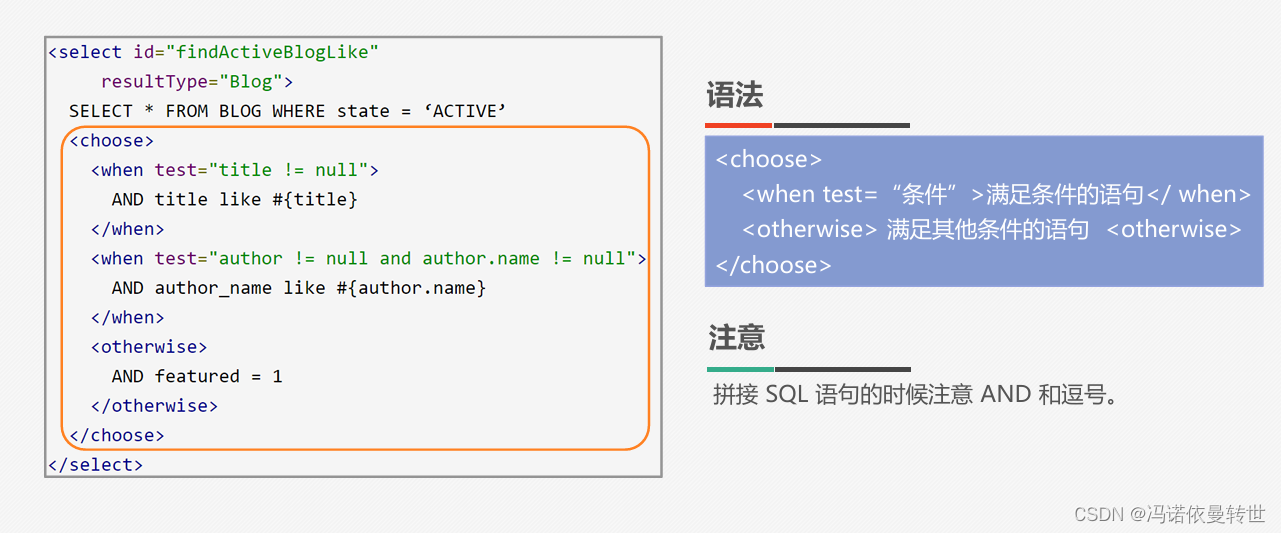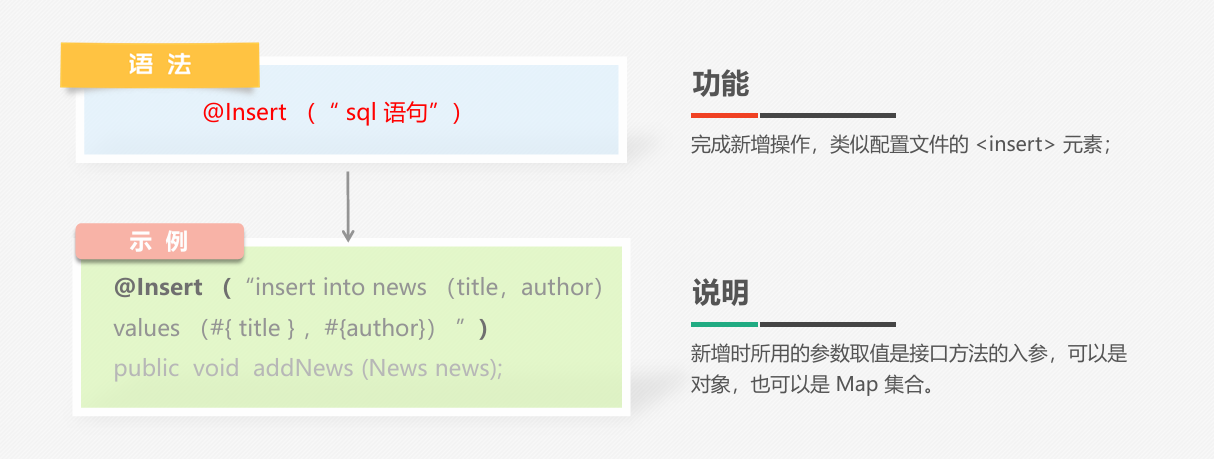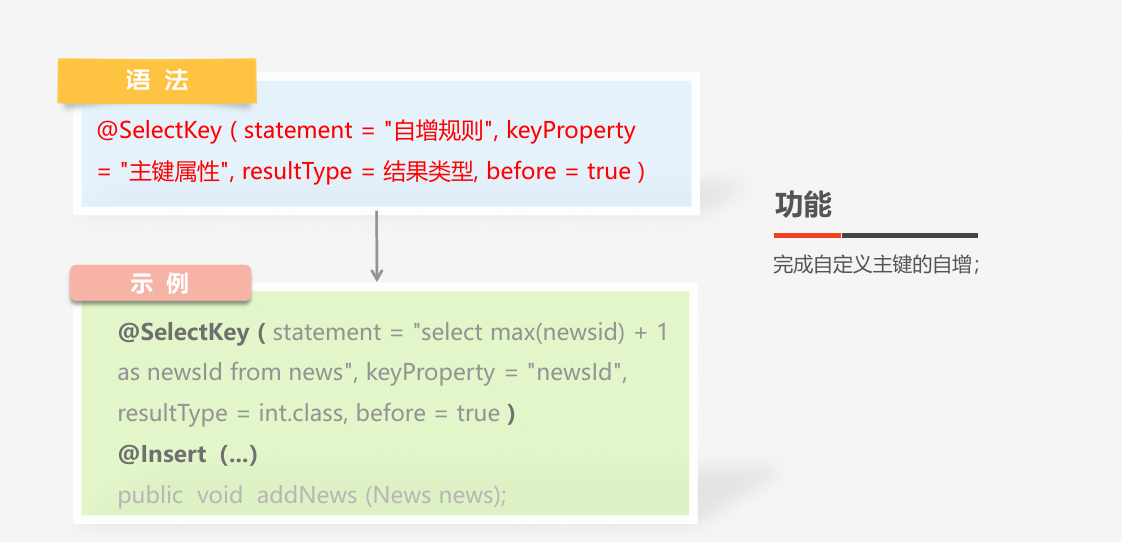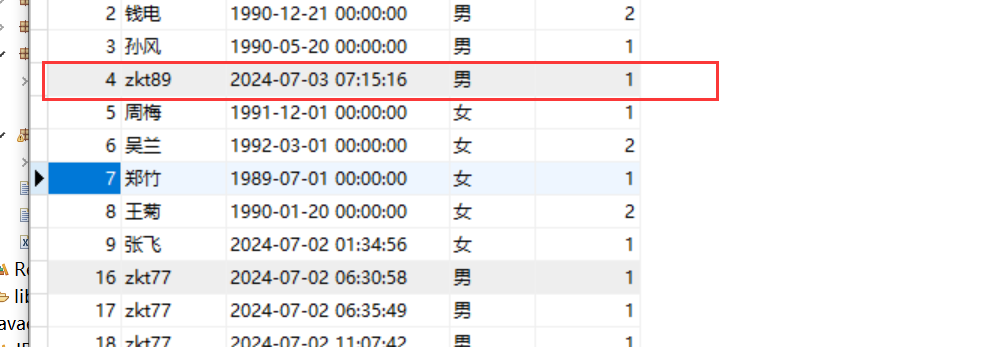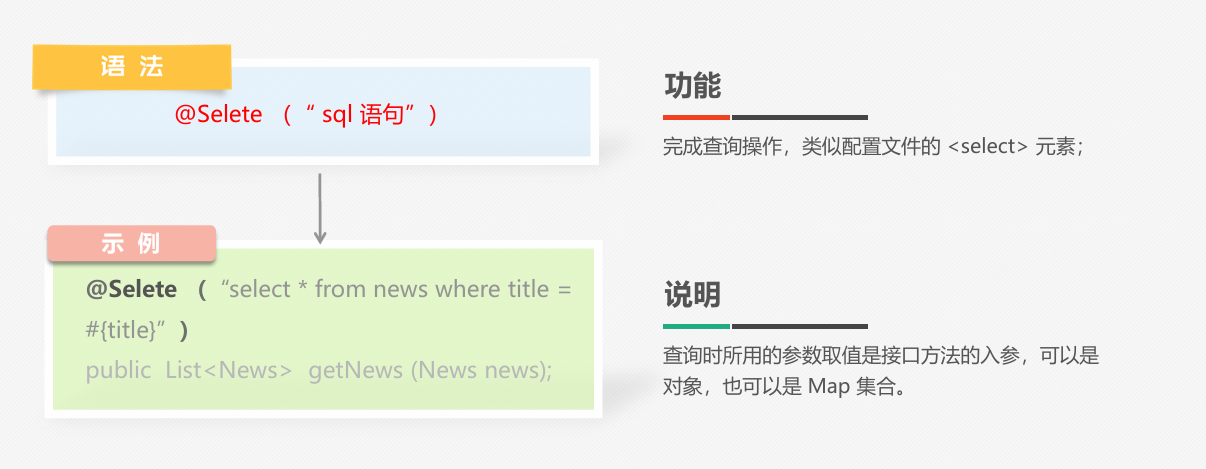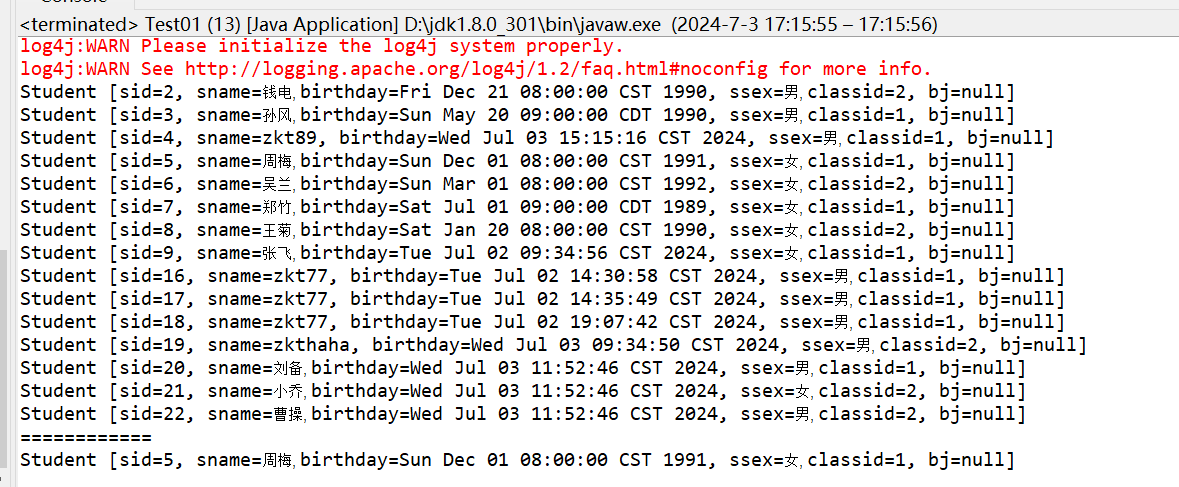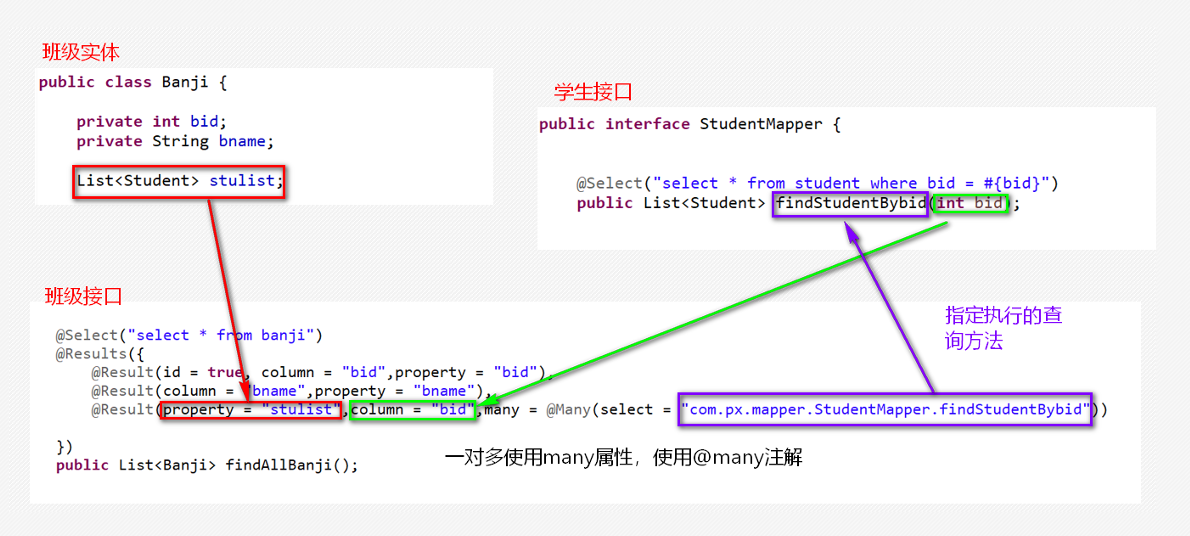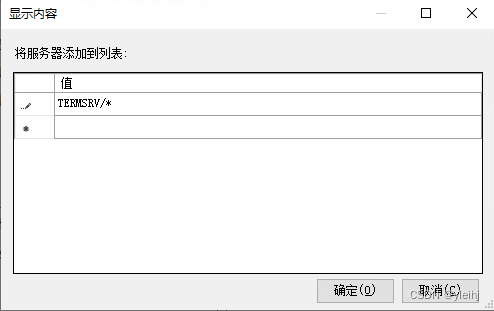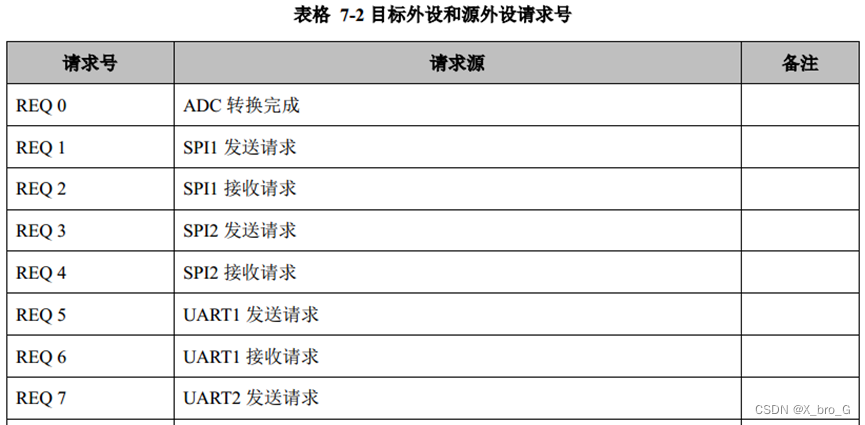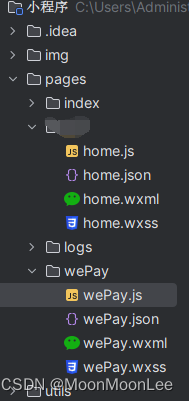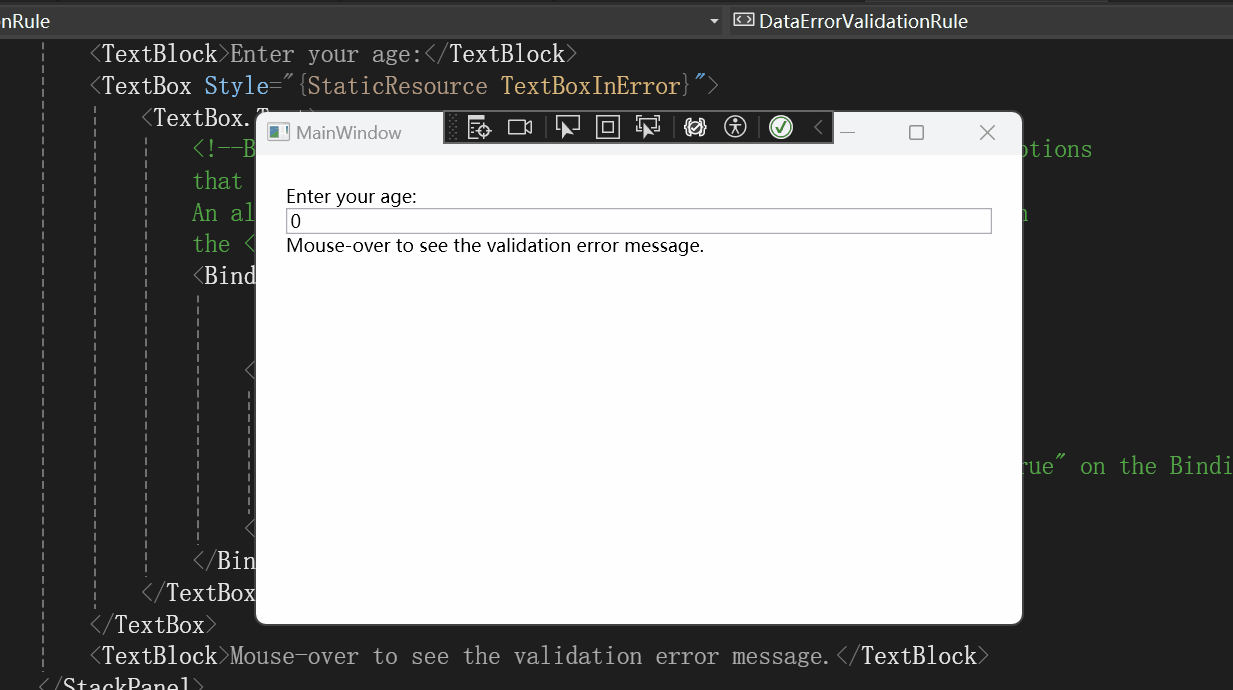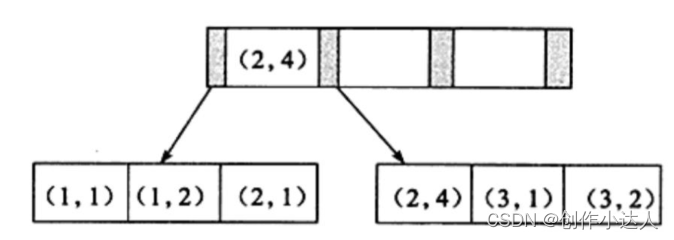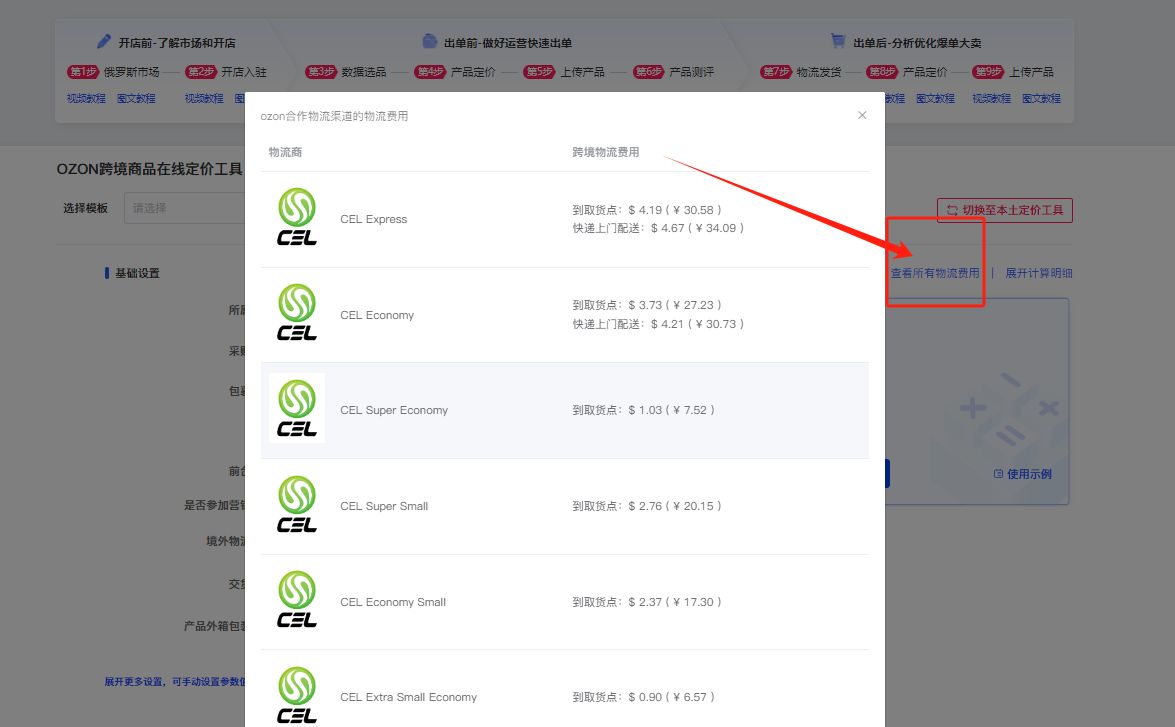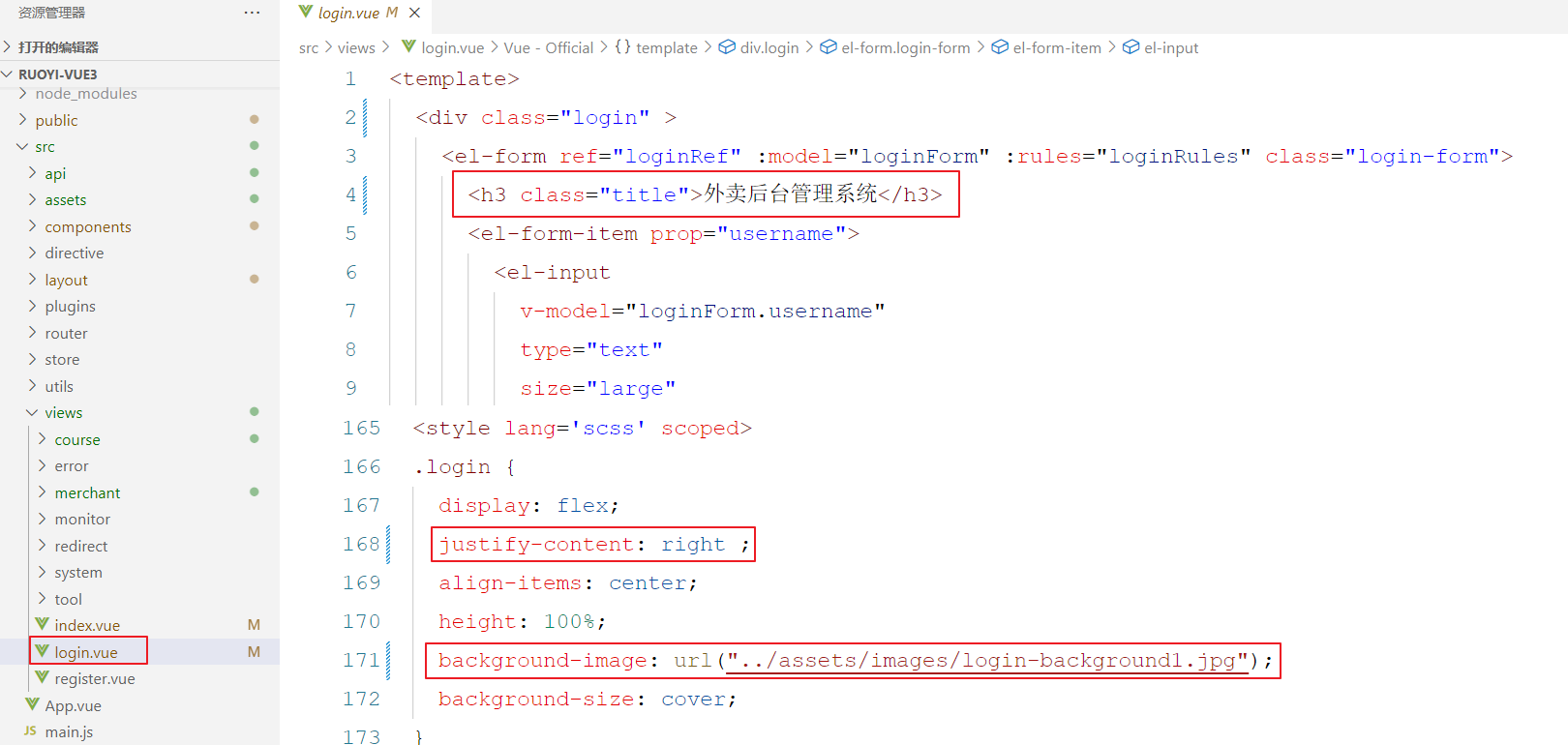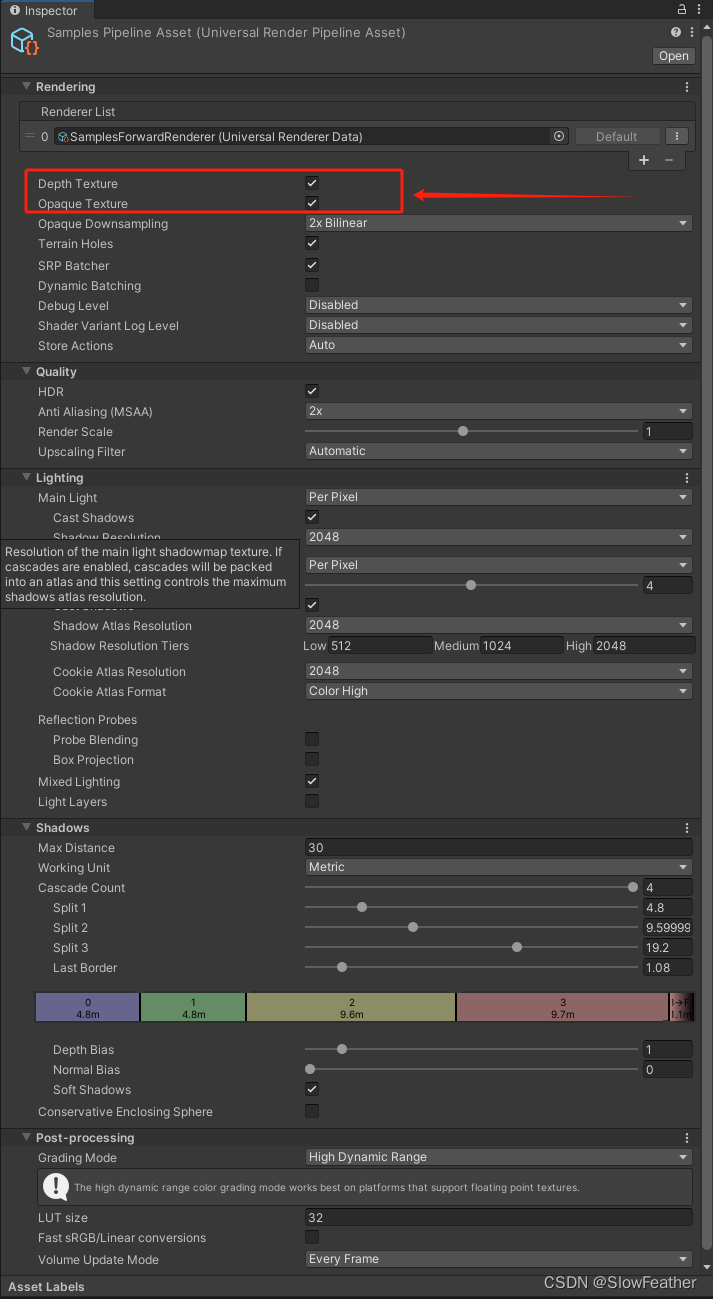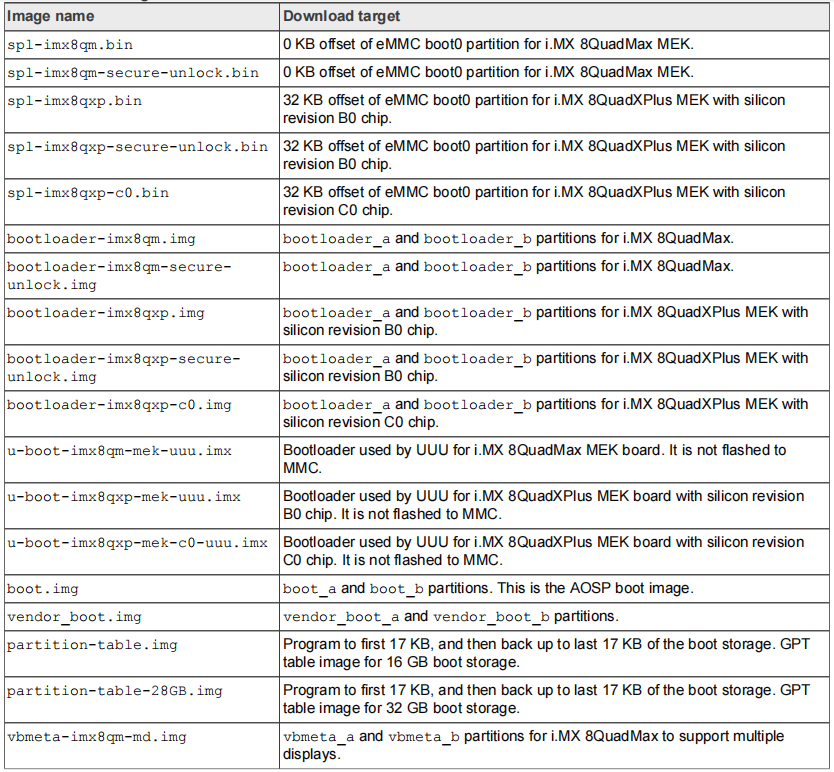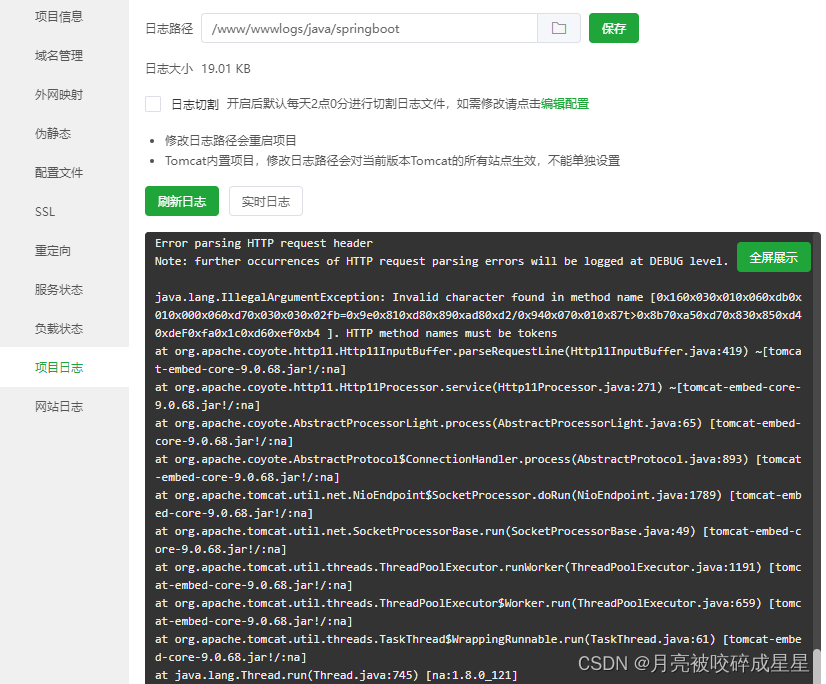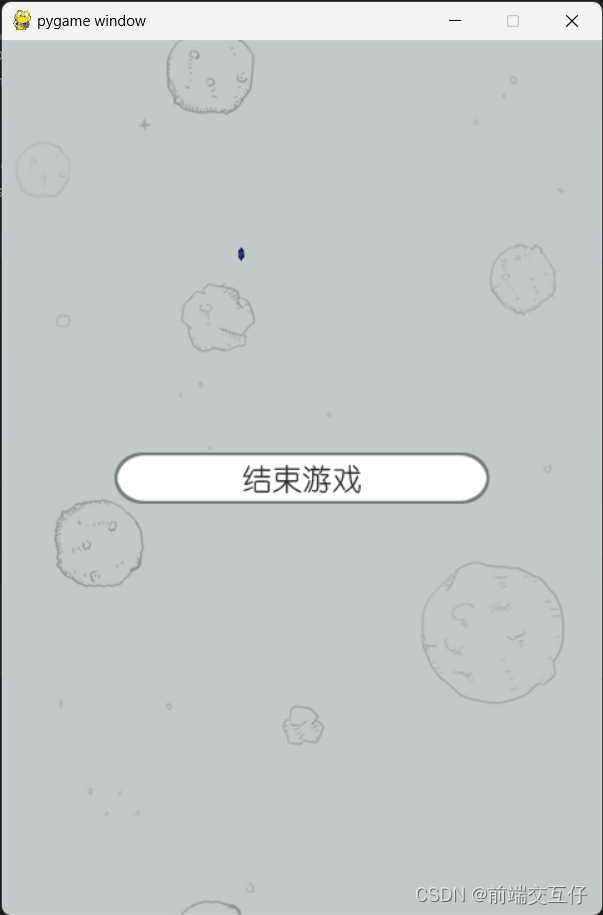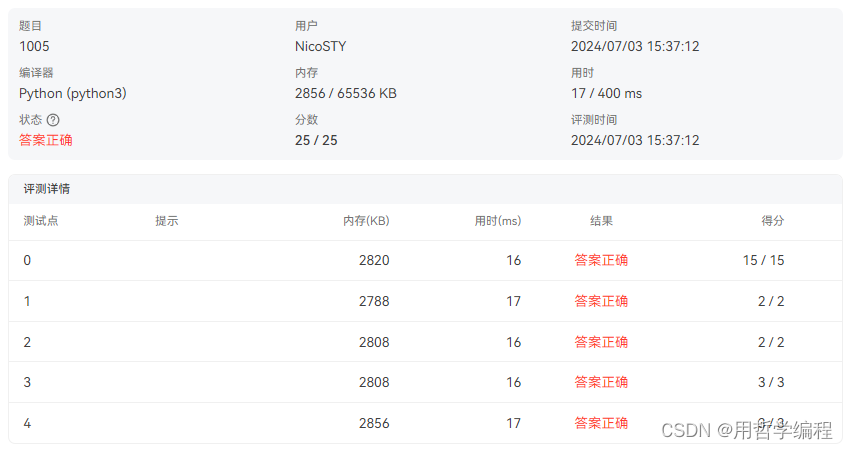目录
一、动态SQL
常用的动态SQL 元素
二、if元素
三、choose 、when 、otherwise 元素
四、trim 、where 、set 元素
trim(不常用)
where
set
五、foreach 元素
六、bind 元素
#{} ${} 区别
示例完整代码
七、映射器注解
八、基本注解
@Insert 新增
主键回填
主键自增
@Delete 删除
@Update 更新
@Selete 查询
传递多个参数的方式:
九、结果映射注解
@Results 结果映射
一对一映射
一对多映射
示例完整代码
一、动态SQL
- 定义:根据不同条件拼接SQL 语句,实现对数据库更准确的操作;
- 实现:映射器配置文件或者注解。
常用的动态SQL 元素
- if 元素:判断语句,单条件分 支判断.
- choose 元素 (when,otherwise): 多条件分支判断,等 同于java 的 switch.
- trim (where,set): 辅助元素,用于处理一些 SQL 拼接的问题.
- foreach 元素 :循环语句,在in 语 句等列举条件常用
- bind 元素 :自定义上下文变量, 传递参数.
二、if元素
语法:
语法 < if test =”条件”> 满足条件的语句 </ if>注意:拼接SQL 语句的时候注意AND 和逗号。
实现:
Student.java 下面所需要的bean同这个一样
public class Student {//属性 对应 数据库中的字段 ---名字一致 类型一致//长像相似就行private int sid;private String sname;private Date birthday;private String ssex;private int classid;//1:1外部属性private Banji bj;get/set 方法 构造方法省略。。。 }StudentMapper.java
// 查询public List<Student> findStudent(Student s);StudentMapper.xml
<!-- OGNL 对象图导航语言 属性 运算符 逻辑 字符串增强 == --><!-- test中的表达式成立 就把if标签里面的字串拼接 --><select id="findStudent" resultType="student" parameterType="student">select * from student where 1=1<if test="ssex != null">and ssex=#{ssex}</if><if test="classid != 0">and classid=#{classid}</if></select>测试:
SqlSession sqlSession = DaoUtil.getSqlSession();StudentMapper stuMapper = sqlSession.getMapper(StudentMapper.class);Student s = new Student();s.setClassid(1); // s.setSsex("男"); // s.setSname("zkt"); // s.setSid(1);List<Student> slist = stuMapper.findStudent(s);slist.forEach(System.out::println);DaoUtil.closeResource(sqlSession);
三、choose 、when 、otherwise 元素
为什么用choose 元素
- 01.场景1 当新闻编号不为空,则只用新闻编号作为查询条件;
- 02.场景2 当新闻编号为空,而新闻标题不为空,则用新闻 标题作为条件进行模糊查询
- 03.场景3 当新闻编号和新闻标题都为空,则要求新闻作者 不能为空
语法:
语法: <choose> <when test=“条件”>满足条件的语句</ when><otherwise> 满足其他条件的语句<otherwise></choose>choose 类似于switch 只要满足条件只走一个
注意:拼接SQL 语句的时候注意AND 和逗号。
实现:
StudentMapper.java
public List<Student> findStudentChoose(Student s);StudentMapper.xml
<select id="findStudentChoose" resultType="student" parameterType="student">select * from student <where><choose><when test="sname != null">and sname = #{sname}</when><when test="ssex != null">and ssex = #{ssex}</when><otherwise>and sid > 10 </otherwise></choose></where></select>测试:
SqlSession sqlSession = DaoUtil.getSqlSession();StudentMapper stuMapper = sqlSession.getMapper(StudentMapper.class);Student s = new Student();s.setClassid(1); // s.setSsex("男"); // s.setSname("zkt"); // s.setSid(1);List<Student> slist = stuMapper.findStudentChoose(s);slist.forEach(System.out::println);DaoUtil.closeResource(sqlSession);
四、trim 、where 、set 元素
trim(不常用)
语法:
语法: <trim prefix = “”suffixOverrides = “” prefixOverrides=“”suffix=“”></trim>prefix 需要拼接的子句,可以是where,or 或者set;suffixOvrrides 忽略通过管道分隔的文本序列后缀。一般不与prefixOvrrides 同时使用prefixOvrrides 忽略通过管道分隔的文本序列前缀。一般不与suffixOvrrides 同时使用实现:
StudentMapper.java
public List<Student> findStudentTrim(Student s);StudentMapper.xml
<!-- trim 万能标签prefix 开始添加一个什么prefixOverrides 开始去掉一个什么suffix 结束添加一个什么suffixOverrides 结束去掉一个什么--><select id="findStudentTrim" parameterType="student" resultType="student">select * from student <trim prefix=" where " prefixOverrides="and" ><if test="ssex != null"> and ssex= #{ssex}</if><if test="classid != 0"> and classid = #{classid}</if></trim></select>测试:
SqlSession sqlSession = DaoUtil.getSqlSession();StudentMapper stuMapper = sqlSession.getMapper(StudentMapper.class);Student s = new Student();s.setClassid(1);s.setSsex("男"); // s.setSname("zkt"); // s.setSid(1);List<Student> slist = stuMapper.findStudentTrim(s);slist.forEach(System.out::println);DaoUtil.closeResource(sqlSession);
实现:
StudentMapper.java
public int addStudent(Student s);StudentMapper.xml
<insert id="addStudent" parameterType="student">insert into student <trim prefix="(" suffix=")" suffixOverrides=","><if test="sid != 0"> sid,</if><if test="sname != null"> sname,</if><if test="birthday != null"> birthday,</if><if test="ssex != null"> ssex,</if><if test="classid != 0"> classid,</if></trim>values<trim prefix="(" suffix=")" suffixOverrides=","><if test="sid != 0"> #{sid},</if><if test="sname != null"> #{sname},</if><if test="birthday != null"> #{birthday},</if><if test="ssex != null"> #{ssex},</if><if test="classid != 0"> #{classid},</if></trim></insert><update id="updateStudentTrim" parameterType="student">update student<trim prefix="set " suffixOverrides=","><if test="sname != null">sname = #{sname},</if><if test="birthday != null">birthday = #{birthday},</if><if test="ssex != null">ssex = #{ssex},</if><if test="classid != 0">classid = #{classid},</if></trim>where sid = #{sid}</update>测试:
SqlSession sqlSession = DaoUtil.getSqlSession();StudentMapper stuMapper = sqlSession.getMapper(StudentMapper.class);Student s = new Student();s.setClassid(1);s.setSsex("男");s.setSname("zkt");s.setSid(1);// int ret = stuMapper.updateStudentSet(s);int ret = stuMapper.addStudent(s);if (ret > 0) {sqlSession.commit();System.out.println("成了");} else {sqlSession.rollback();System.out.println("凉了");}DaoUtil.closeResource(sqlSession);
where
语法:
语法: <where><if test =”条件”> 满足条件的语句 </if></where>说明:where 元素只会在至少有一个子元素的 条件返回SQL 子句的情况下才去插入 “WHERE”子句。而且,若语句的开头为 “AND”或“OR”,where 元素也会将它们去除。
实现:
StudentMapper.java
public List<Student> findStudentWhere(Student s);StudentMapper.xml
<!-- where标签 1.添加一个where关键词 2. 去掉where后的第一个and 3.当没where标签中没有任何成立的字串时 什么也不添加 --><select id="findStudentWhere" resultType="student" parameterType="student">select * from student<where><if test="ssex != null">and ssex=#{ssex}</if><if test="classid != 0">and classid=#{classid}</if></where></select>测试:
SqlSession sqlSession = DaoUtil.getSqlSession();StudentMapper stuMapper = sqlSession.getMapper(StudentMapper.class);Student s = new Student();s.setClassid(1);s.setSsex("男"); // s.setSname("zkt"); // s.setSid(1);List<Student> slist = stuMapper.findStudentWhere(s);slist.forEach(System.out::println);DaoUtil.closeResource(sqlSession);
set
语法:
语法: <set><if test =”条件”> 满足条件的语句 </if></set>说明:set 标签元素主要是用在更新操作的时候, 它的主要功能和where 标签元素其实是差不 多的,主要是在包含的语句前输出一个set, 然后如果包含的语句是以逗号结束的话将会 把该逗号忽略,如果set 包含的内容为空的 话则会出错。有了set 元素就可以动态的更 新那些修改了的字段。
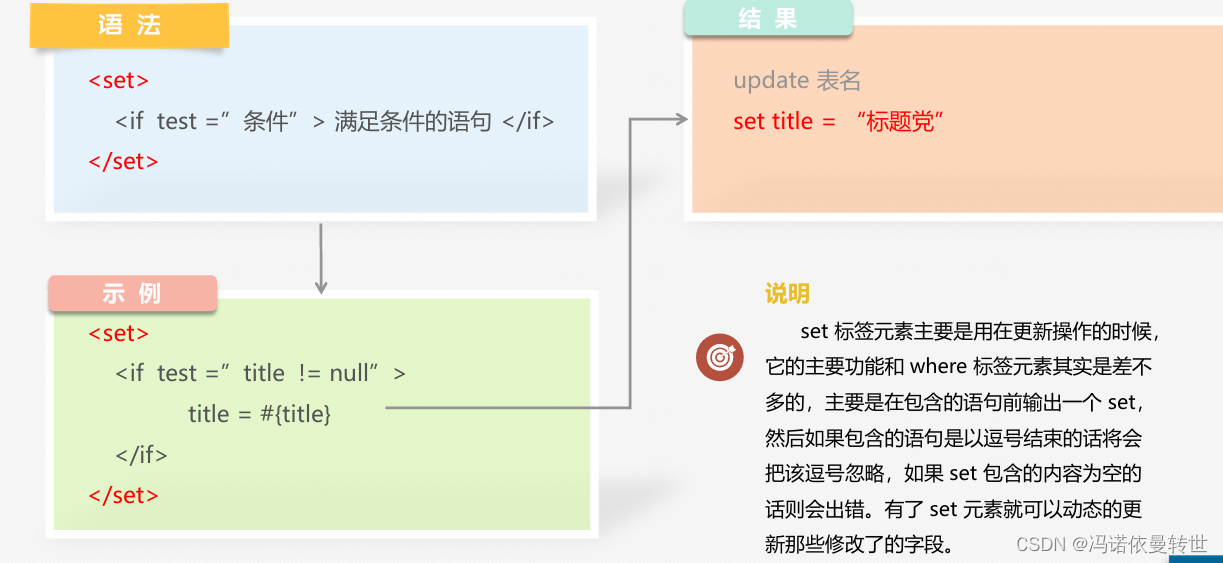
实现:
StudentMapper.java
public int updateStudentSet(Student s);StudentMapper.xml
<update id="updateStudentSet" parameterType="student">update student<set><if test="sname != null">sname = #{sname},</if><if test="birthday != null">birthday = #{birthday},</if><if test="ssex != null">ssex = #{ssex},</if><if test="classid != 0">classid = #{classid}</if></set>where sid = #{sid}</update>测试:
SqlSession sqlSession = DaoUtil.getSqlSession();StudentMapper stuMapper = sqlSession.getMapper(StudentMapper.class);Student s = new Student(); // s.setSsex("男");s.setClassid(2);s.setSid(19);s.setSname("zkthah");int ret = stuMapper.updateStudentSet(s);if (ret > 0) {System.out.println("成功");sqlSession.commit();} else {System.out.println("失败");sqlSession.rollback();}DaoUtil.closeResource(sqlSession);
五、foreach 元素
语法:
语法: <foreach item = “”index=“” collection=“” open=“” separator=“” close=“”></foreach>item 循环中的当前元素; index 当前循环元素的位置下标; collection 方法传递的参数,一个数组或者集合; close 以什么符号结束将这些集合元素包装起来; open 以什么符号开始将这些集合元素包装起来; separator 各个元素的间隔符号。参数是数组
实现:
StudentMapper.java
public List<Student> findStudentArray(int[] arr);StudentMapper.xml
<select id="findStudentArray" resultType="student" >select * from student<where><foreach collection="array" item="x" open=" sid in(" close=")" index="i" separator=",">#{x}</foreach> </where></select>测试:
SqlSession sqlSession = DaoUtil.getSqlSession();StudentMapper stuMapper = sqlSession.getMapper(StudentMapper.class);int[] arr = { 1, 2, 3, 4, 5, 6, 7 };List<Student> slist = stuMapper.findStudentArray(arr);slist.forEach(System.out::println);DaoUtil.closeResource(sqlSession);
参数是ArrayList
实现:
StudentMapper.java
public List<Student> findStudentList(List<Integer> sidList);StudentMapper.xml
<select id="findStudentList" resultType="student" >select * from student<where><foreach collection="list" item="x" open=" sid in(" close=")" index="i" separator=",">#{x}</foreach> </where></select>测试:
SqlSession sqlSession = DaoUtil.getSqlSession();StudentMapper stuMapper = sqlSession.getMapper(StudentMapper.class);List<Integer> sidlist = new ArrayList<Integer>();sidlist.add(1);sidlist.add(2);sidlist.add(3);sidlist.add(4);sidlist.add(5);List<Student> slist = stuMapper.findStudentList(sidlist);slist.forEach(System.out::println);DaoUtil.closeResource(sqlSession);
批量增加
实现:
StudentMapper.java
// 批量增加public int addStudentList(List<Student> stuList);StudentMapper.xml
<insert id="addStudentList" >insert into student (sname,birthday,ssex,classid)values<foreach collection="list" item="stu" separator=",">(#{stu.sname},#{stu.birthday},#{stu.ssex},#{stu.classid})</foreach></insert>测试:
SqlSession sqlSession = DaoUtil.getSqlSession();StudentMapper stuMapper = sqlSession.getMapper(StudentMapper.class);Student s1 = new Student();s1.setBirthday(new Date());s1.setClassid(1);s1.setSname("刘备");s1.setSsex("男");Student s2 = new Student();s2.setBirthday(new Date());s2.setClassid(2);s2.setSname("小乔");s2.setSsex("女");Student s3 = new Student();s3.setBirthday(new Date());s3.setClassid(2);s3.setSname("曹操");s3.setSsex("男");List<Student> stulist = new ArrayList<Student>();stulist.add(s1);stulist.add(s2);stulist.add(s3);int ret = stuMapper.addStudentList(stulist);if (ret == stulist.size()) {sqlSession.commit();System.out.println("成了");} else {sqlSession.rollback();System.out.println("凉了");}DaoUtil.closeResource(sqlSession);
六、bind 元素
定义一个变量
语法:
语法: <bind name=“”value=“_parameter”></bind>name 自定义变量的变量名 value 自定义变量的变量值 _parameter 传递进来的参数实现:
StudentMapper.java
// 模糊查询public List<Student> findStudentLikeSname(String keyname);StudentMapper.xml
<select id="findStudentLikeSname" parameterType="String" resultType="Student"><!-- select * from student where sname like '%#{v}%' --><!-- 方式一 业务层解决 --><!-- select * from student where sname like #{v} --><!-- 方式二 concat 推荐--><!-- select * from student where sname like concat('%',#{v},'%') --><!-- 方式三 ${} ${} 和 #{} 区别 *****--><!-- select * from student where sname like '%${v}%' --><!-- 方式四 sql语法 --><!-- select * from student where sname like "%"#{v}"%" --><!-- 方式五 bind 推荐--><bind name="kk" value="'%'+_parameter+'%'"/>select * from student where sname like #{kk}</select>测试:
SqlSession sqlSession = DaoUtil.getSqlSession();StudentMapper stuMapper = sqlSession.getMapper(StudentMapper.class); List<Student> slist = stuMapper.findStudentLikeSname("张");slist.forEach(System.out::println);DaoUtil.closeResource(sqlSession);方式一:在 张 前后加%%即
List<Student> slist = stuMapper.findStudentLikeSname("%张%");
#{} ${} 区别
#{}匹配的是一个占位符,相当于JDBC中的一个?,会对一些敏感的字符进行过滤,编译过后会对传递的值加上双引号,因此可以防止SQL注入问题。${}匹配的是真实传递的值,传递过后,会与sql语句进行字符串拼接。${}会与其他sql进行字符串拼接,不能预防sql注入问题。#{}是预编译处理,$ {}是字符串替换。
mybatis在处理#{}时,会将sql中的#{}替换为?号,调用PreparedStatement的set方法来赋值;
mybatis在处理 $ { } 时,就是把 ${ } 替换成变量的值。使用 #{} 可以有效的防止SQL注入,提高系统安全性。
示例完整代码
StudentMapper.java
public interface StudentMapper {// 查询public List<Student> findStudent(Student s);public List<Student> findStudentWhere(Student s);public List<Student> findStudentChoose(Student s);public int updateStudentSet(Student s);public List<Student> findStudentTrim(Student s);public int updateStudentTrim(Student s);public int addStudent(Student s);public List<Student> findStudentArray(int[] arr);public List<Student> findStudentList(List<Integer> sidList);// 批量增加public int addStudentList(List<Student> stuList);// 模糊查询public List<Student> findStudentLikeSname(String keyname);}StudentMapper.xml
<?xml version="1.0" encoding="UTF-8" ?> <!DOCTYPE mapperPUBLIC "-//mybatis.org//DTD Mapper 3.0//EN""http://mybatis.org/dtd/mybatis-3-mapper.dtd"><mapper namespace="com.zkt.mapper.StudentMapper"><!-- OGNL 对象图导航语言 属性 运算符 逻辑 字符串增强 == --><!-- test中的表达式成立 就把if标签里面的字串拼接 --><select id="findStudent" resultType="student" parameterType="student">select * from student where 1=1<if test="ssex != null">and ssex=#{ssex}</if><if test="classid != 0">and classid=#{classid}</if></select><!-- where标签 1.添加一个where关键词 2. 去掉where后的第一个and 3.当没where标签中没有任何成立的字串时 什么也不添加 --><select id="findStudentWhere" resultType="student" parameterType="student">select * from student<where><if test="ssex != null">and ssex=#{ssex}</if><if test="classid != 0">and classid=#{classid}</if></where></select><select id="findStudentChoose" resultType="student" parameterType="student">select * from student<where><choose><when test="sname != null">and sname=#{sname}</when><when test="ssex != null">and ssex=#{ssex}</when><otherwise>and sid > 10</otherwise></choose></where></select><update id="updateStudentSet" parameterType="student">update student<set><if test="sname != null">sname = #{sname},</if><if test="birthday != null">birthday = #{birthday},</if><if test="ssex != null">ssex = #{ssex},</if><if test="classid != 0">classid = #{classid}</if></set>where sid = #{sid}</update><!-- trim 万能标签prefix 开始添加一个什么prefixOverrides 开始去掉一个什么suffix 结束添加一个什么suffixOverrides 结束去掉一个什么--><select id="findStudentTrim" parameterType="student" resultType="student">select * from student <trim prefix=" where " prefixOverrides="and" ><if test="ssex != null"> and ssex= #{ssex}</if><if test="classid != 0"> and classid = #{classid}</if></trim></select><update id="updateStudentTrim" parameterType="student">update student<trim prefix="set " suffixOverrides=","><if test="sname != null">sname = #{sname},</if><if test="birthday != null">birthday = #{birthday},</if><if test="ssex != null">ssex = #{ssex},</if><if test="classid != 0">classid = #{classid},</if></trim>where sid = #{sid}</update><insert id="addStudent" parameterType="student">insert into student <trim prefix="(" suffix=")" suffixOverrides=","><if test="sid != 0"> sid,</if><if test="sname != null"> sname,</if><if test="birthday != null"> birthday,</if><if test="ssex != null"> ssex,</if><if test="classid != 0"> classid,</if></trim>values<trim prefix="(" suffix=")" suffixOverrides=","><if test="sid != 0"> #{sid},</if><if test="sname != null"> #{sname},</if><if test="birthday != null"> #{birthday},</if><if test="ssex != null"> #{ssex},</if><if test="classid != 0"> #{classid},</if></trim></insert><select id="findStudentArray" resultType="student">select * from student<where> <foreach collection="array" item="x" open="sid in(" close=")" index="i" separator=",">#{x}</foreach></where></select><select id="findStudentList" resultType="student">select * from student<where> <foreach collection="list" item="x" open="sid in(" close=")" index="i" separator=",">#{x}</foreach></where></select><insert id="addStudentList" >insert into student (sname,birthday,ssex,classid)values<foreach collection="list" item="stu" separator=",">(#{stu.sname},#{stu.birthday},#{stu.ssex},#{stu.classid})</foreach></insert><select id="findStudentLikeSname" parameterType="String" resultType="Student"><!-- select * from student where sname like '%#{v}%' --><!-- 方式一 业务层解决 --><!-- select * from student where sname like #{v} --><!-- 方式二 concat 推荐--><!-- select * from student where sname like concat('%',#{v},'%') --><!-- 方式三 ${} ${} 和 #{} 区别 *****--><!-- select * from student where sname like '%${v}%' --><!-- 方式四 sql语法 --><!-- select * from student where sname like "%"#{v}"%" --><!-- 方式五 bind 推荐--><bind name="kk" value="'%'+_parameter+'%'"/>select * from student where sname like #{kk}</select></mapper>测试:
public class Test01 {public static void main(String[] args) {SqlSession sqlSession = DaoUtil.getSqlSession();StudentMapper stuMapper = sqlSession.getMapper(StudentMapper.class);Student s = new Student(); // s.setClassid(1); // s.setSsex("男"); // s.setSname("zkt"); // s.setSid(1);// List<Student> slist = stuMapper.findStudent(s); // List<Student> slist = stuMapper.findStudentWhere(s); // List<Student> slist = stuMapper.findStudentChoose(s); // List<Student> slist = stuMapper.findStudentTrim(s);// int[] arr = {1,2,3,4,5,6,7}; // List<Student> slist = stuMapper.findStudentArray(arr);// List<Integer> sidlist = new ArrayList<Integer>(); // sidlist.add(1); // sidlist.add(2); // sidlist.add(3); // sidlist.add(4); // sidlist.add(5); // List<Student> slist = stuMapper.findStudentList(sidlist);List<Student> slist = stuMapper.findStudentLikeSname("张");slist.forEach(System.out::println);// int ret = stuMapper.updateStudentSet(s); // int ret = stuMapper.addStudent(s);// Student s1 = new Student(); // s1.setBirthday(new Date()); // s1.setClassid(1); // s1.setSname("刘备"); // s1.setSsex("男"); // // Student s2 = new Student(); // s2.setBirthday(new Date()); // s2.setClassid(2); // s2.setSname("小乔"); // s2.setSsex("女"); // // Student s3 = new Student(); // s3.setBirthday(new Date()); // s3.setClassid(2); // s3.setSname("曹操"); // s3.setSsex("男"); // // List<Student> stulist = new ArrayList<Student>(); // stulist.add(s1); // stulist.add(s2); // stulist.add(s3); // // int ret = stuMapper.addStudentList(stulist); // // if(ret == stulist.size()) { // sqlSession.commit(); // System.out.println("成了"); // }else { // sqlSession.rollback(); // System.out.println("凉了"); // }DaoUtil.closeResource(sqlSession);} }
七、映射器注解
映射器配置文件的缺陷
- 繁琐:配置文件的书写本身繁琐,需要掌 握的内容比较多
- 不直观:配置文件和接口直接只是名称相同, 对应起来比较麻烦.
常用的注解
- 基本注解:实现简单的增删改查操作。
- 结果映射注解:实现结果的映射关系, 也可以完成级联映射。
- 动态SQL注解:实现动态 SQL 的内容
八、基本注解
基本注解的分类
- 增加操作 @Insert 类似 < insert > 完成新增
- 删除操作 @Delete 类似 < delete > 完成删除
- 修改操作 @Update 类似 < update > 完成修改
- 查询操作 @Select 类似 < select > 完成查询
@Insert 新增
功能:完成新增操作,类似配置文件的<insert>元素;
说明:新增时所用的参数取值是接口方法的入参,可以是对象,也可以是 Map 集合。
语法:
语法: @Insert (“ sql 语句”)
主键回填
功能:完成数据库自增主键的回填;
语法:
语法: @Options(useGeneratedKeys = true, keyProperty = "主键属性")
StudentMapper.java
//新增 -- 主键回填@Insert("insert into student(sname,birthday,ssex,classid)"+ "values(#{sname},#{birthday},#{ssex},#{classid})")@Options(useGeneratedKeys = true,keyProperty = "sid")public int addStudent(Student s);测试:
SqlSession sqlSession = DaoUtil.getSqlSession();StudentMapper stuMapper = sqlSession.getMapper(StudentMapper.class);Student s = new Student();s.setClassid(1);s.setSsex("男");s.setSname("zkt89");s.setBirthday(new Date()); // s.setSid(1);System.out.println("添加前"+s);int ret = stuMapper.addStudent(s);System.out.println("添加后"+s);if(ret >0) {sqlSession.commit();System.out.println("成了");}else {sqlSession.rollback();System.out.println("凉了");}DaoUtil.closeResource(sqlSession);

主键自增
功能:完成自定义主键的自增;
语法:
语法: @SelectKey ( statement = "自增规则", keyProperty = "主键属性", resultType = 结果类型, before = true )
@Delete 删除
功能:完成删除操作,类似配置文件的<delete>元素;
说明:删除时所用的参数取值是接口方法的入参,可以是对象,也可以是 Map 集合。
语法:
语法: @Delete (“ sql 语句”)
示例:
StudentMapper.java
@Delete("delete from student where sid = #{v}")public int deleteStudent(int sid);测试:
SqlSession sqlSession = DaoUtil.getSqlSession();StudentMapper stuMapper = sqlSession.getMapper(StudentMapper.class);int ret = stuMapper.deleteStudent(23);if (ret > 0) {sqlSession.commit();System.out.println("成了");} else {sqlSession.rollback();System.out.println("凉了");}DaoUtil.closeResource(sqlSession);
@Update 更新
功能:完成更新操作,类似配置文件的<update>元素;
说明:更新时所用的参数取值是接口方法的入参,可以是对象,也可以是Map 集合。
语法:
语法: @Update (“ sql 语句”)
示例:
StudentMapper.java
@Update("update student set sname=#{sname},birthday=#{birthday},"+ "ssex=#{ssex},classid=#{classid} where sid=#{sid}") public int updateStudent(Student s);测试:
SqlSession sqlSession = DaoUtil.getSqlSession();StudentMapper stuMapper = sqlSession.getMapper(StudentMapper.class);Student s = new Student();s.setClassid(1);s.setSsex("男");s.setSname("zkt89");s.setBirthday(new Date());s.setSid(4);int ret = stuMapper.updateStudent(s);if (ret > 0) {sqlSession.commit();System.out.println("成了");} else {sqlSession.rollback();System.out.println("凉了");}DaoUtil.closeResource(sqlSession);
@Selete 查询
功能:完成查询操作,类似配置文件的 <select>元素;
说明:查询时所用的参数取值是接口方法的入参,可以是 对象,也可以是 Map 集合。
语法:
语法: @Selete (“ sql 语句”)
示例:
StudentMapper.java
@Select("select * from student")public List<Student> findStudent();@Select("select * from student where sid = #{v}")public Student findStudentBySid(int Sid);测试:
SqlSession sqlSession = DaoUtil.getSqlSession();StudentMapper stuMapper = sqlSession.getMapper(StudentMapper.class);List<Student> slist = stuMapper.findStudent();slist.forEach(System.out::println);System.out.println("============");Student s = stuMapper.findStudentBySid(5);System.out.println(s);DaoUtil.closeResource(sqlSession);
注解和sqlMapper.xml 可以同时使用
注解底层还是sqlMapper 方法还是不能重载
传递多个参数的方式:
- 方法1:Map 方式 跟sqlmap一样
- 方法2:JavaBean 方式 跟sqlmap一样
- 方法3:@Param 方式
示例:
StudentMapper.java
//多参 4 javabean map arg0... param1...//@Param@Select("select * from student where ssex = #{sex} and classid=#{banjibianhao} limit #{cp},#{sp}")public List<Student> findStudentBySexAndClassidPage(@Param("sex")String sex,@Param("banjibianhao")int classid,@Param("cp")int curpage,@Param("sp")int sizepage);测试:
SqlSession sqlSession = DaoUtil.getSqlSession();StudentMapper stuMapper = sqlSession.getMapper(StudentMapper.class);List<Student> slist = stuMapper.findStudentBySexAndClassidPage("男", 1, (1-1)*3, 3);slist.forEach(System.out::println);DaoUtil.closeResource(sqlSession);
九、结果映射注解
@Results 结果映射
功能: 完成数据库字段和 JavaBean 属性的映射关系;
说明:每个 @Results 可以包含多个 @Result,其中通过 id 属性来判断是否为主键。
语法:
语法: @Results({ @Result(id = 是否为主键, column = "字段", property = "属性" ) })
@Results 复用
示例:
SMasterMapper .java
@Results({ @Result(column = "sm_name", property = "smname") })@Select("select * from schoolmaster")public List<SMaster> findAllSm();@Select("select * from schoolmaster where smid = #{v}")public SMaster findSmBySmid(int smid);测试:
SqlSession sqlSession = DaoUtil.getSqlSession();SMasterMapper smMapper = sqlSession.getMapper(SMasterMapper.class);List<SMaster> smlist = smMapper.findAllSm();smlist.forEach(System.out::println);SMaster sm = smMapper.findSmBySmid(1);System.out.println(sm);
注解映射各用各的
一对一映射
功能:一对一的关系映射;
说明:FetchType.lazy 是延时加载,FetchType.EAGER 是即时加载。
语法:
语法: @One( Select = 一对一查询方法, fetchType = FetchType.EAGER )
示例:
StudentMapper.java
@Results({@Result(column = "classid",property = "bj", one=@One(select = "com.ape.mapper.BanjiMapper.findBanjiByClassid"))})@Select("select * from student ")public List<Student> findStudentAndClass();BanjiMapper.java
@Select("select * from class where classid=#{classid}")public Banji findBanjiByClassid(int classid);测试:
SqlSession sqlSession =DaoUtil.getSqlSession();StudentMapper stuMapper =sqlSession.getMapper(StudentMapper.class);List<Student> sList = stuMapper.findStudentAndClass();sList.forEach(System.out::println);DaoUtil.closeResource(sqlSession);
注解没有表联查 只有单表和自己写的映射关系
一对一映射的实现案例
一对多映射
功能:一对多的关系映射;
说明:FetchType.lazy 是延时加载,FetchType.EAGER 是即时加载。
语法:
语法: @Many( Select = 一对多查询方法, fetchType = FetchType.EAGER )
示例:
BanjiMapper.java
@Results({@Result(column = "classid",property = "classid"),@Result(column = "classid",property = "sList",many =@Many(select = "com.zkt.mapper.StudentMapper.findStudentByClassid"))})@Select("select * from class")public List<Banji> findAllBanji();StudentMapper.java
@Select("select * from student where classid=#{v}")public List<Student> findStudentByClassid(int classid);测试:
SqlSession sqlSession = DaoUtil.getSqlSession();BanjiMapper bjmapper = sqlSession.getMapper(BanjiMapper.class);List<Banji> bjList = bjmapper.findAllBanji();bjList.forEach(System.out::println);DaoUtil.closeResource(sqlSession);
一对多映射的实现案例
示例完整代码
实体类同mybatis2
BanjiMapper.java
public interface BanjiMapper {@Select("select * from class where classid=#{classid}")public Banji findBanjiByClassid(int classid);@Results({ @Result(column = "classid", property = "classid"),@Result(column = "classid", property = "sList", many = @Many(select = "com.zkt.mapper.StudentMapper.findStudentByClassid")) })@Select("select * from class")public List<Banji> findAllBanji();}StudentMapper.java
public interface StudentMapper {@Select("select * from student")public List<Student> findStudent();@Select("select * from student where sid = #{v}")public Student findStudentBySid(int Sid);// 多参 4 javabean map arg0... param1...// @Param@Select("select * from student where ssex = #{sex} and classid=#{banjibianhao} limit #{cp},#{sp}")public List<Student> findStudentBySexAndClassidPage(@Param("sex") String sex, @Param("banjibianhao") int classid,@Param("cp") int curpage, @Param("sp") int sizepage);// 新增 -- 主键回填@Insert("insert into student(sname,birthday,ssex,classid)" + "values(#{sname},#{birthday},#{ssex},#{classid})")@Options(useGeneratedKeys = true, keyProperty = "sid")public int addStudent(Student s);@Update("update student set sname=#{sname},birthday=#{birthday},"+ "ssex=#{ssex},classid=#{classid} where sid=#{sid}")public int updateStudent(Student s);@Delete("delete from student where sid = #{v}")public int deleteStudent(int sid);@Results({@Result(column = "classid", property = "bj", one = @One(select = "com.zkt.mapper.BanjiMapper.findBanjiByClassid")) })@Select("select * from student")public List<Student> findStudentAndClass();@Select("select * from student where classid=#{v}")public List<Student> findStudentByClassid(int classid);}测试1
public class Test01 {public static void main(String[] args) {SqlSession sqlSession = DaoUtil.getSqlSession();StudentMapper stuMapper = sqlSession.getMapper(StudentMapper.class);Student s = new Student();s.setClassid(1);s.setSsex("男");s.setSname("zkt89");s.setBirthday(new Date());s.setSid(4);// List<Student> slist = stuMapper.findStudent(); // // slist.forEach(System.out::println);// System.out.println("============="); // Student s = stuMapper.findStudentBySid(5); // System.out.println(s);List<Student> slist = stuMapper.findStudentBySexAndClassidPage("男", 1, (1-1)*3, 3);slist.forEach(System.out::println);// System.out.println("添加前"+s); // int ret = stuMapper.addStudent(s); // System.out.println("添加后"+s);// int ret = stuMapper.updateStudent(s); // int ret = stuMapper.deleteStudent(23); // if (ret > 0) { // sqlSession.commit(); // System.out.println("成了"); // } else { // sqlSession.rollback(); // System.out.println("凉了"); // }DaoUtil.closeResource(sqlSession);} }测试3
public class Test03 {public static void main(String[] args) {SqlSession sqlSession = DaoUtil.getSqlSession(); // StudentMapper stuMapper =sqlSession.getMapper(StudentMapper.class); // List<Student> sList = stuMapper.findStudentAndClass(); // sList.forEach(System.out::println);BanjiMapper bjmapper = sqlSession.getMapper(BanjiMapper.class);List<Banji> bjList = bjmapper.findAllBanji();bjList.forEach(System.out::println);DaoUtil.closeResource(sqlSession);} }


